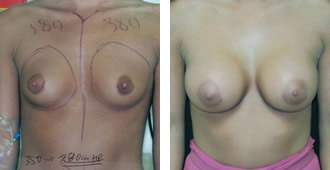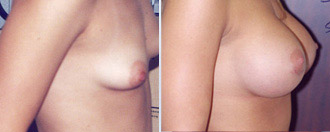BEVERLY HILLS BREAST IMPLANTS: WHAT TO EXPECT AND HOW TO PREPARE
Posted On: July 08, 2007 Author: The Office of Dr. Stuart Linder Posted In: Breast Asymmetry, Breast Augmentation, Breast Implants, Breast topics, Plastic Surgery
When considering breast augmentation surgery with the use of breast implants, your first step should be to make sure that you are an acceptable candidate for the surgery. Speak with or consult a Board Certified Plastic Surgeon with the American Board of Plastic Surgery. There are no substitutes. After meeting with the plastic surgeon, it is vital that the patients have realistic expectations and that they review many pictures of the doctor’s work, from both frontal and oblique views.
Once the size of the breast implant has been determined, it is important that the patient understand the approach the doctor will use to place the implant, as well as the issues of safety and why a particular approach is being used. Dr. Linder prefers the periareolar incision; it affords a safe and predictable result and allows the implants to be placed perfectly. A subpectoral dual plane technique is also favored and allows for muscle coverage, which reduces visibility, rippling of the implant medially, the occurrence of capsular contracture, (scar tissue formation), and allows for a more accurate mammography. This is important in the detection of small types of breast cancers.
WHAT TO DO BEFORE THE BREAST IMPLANT PROCEDURE IN BEVERLY HILLS
Once the patient has decided to proceed with the surgery, a preoperative visit should be performed. This is scheduled on a different date than the initial consultation, in order to discuss the following topics once again; size, shape, surgical approach and postoperative management with the surgeon directly.
Some of the issues that we try to impress upon our patients which are of the utmost important, at least in our practice are; that the patient refrains from taking aspirin, and products containing aspirin for 14 days prior to and after their surgery, these include but are not limited to: Advil, Motrin, Excedrin, Ibuprofen, Naprosyn, etc. These products may cause platelet dysfunction and/or thin the blood preventing clotting during the operation or immediately postoperatively.
The patient should also refrain from smoking for two weeks before and after and terminate any alcohol use for at least one week prior to and one week after your surgery. In our practice these are the rules and they are in place to help the patient heal quickly and without complication.
ABOUT OUR BREAST IMPLANT PROCEDURE IN BEVERLY HILLS
Patients are given intravenous antibiotics 30 minutes prior to surgery; this is done to help reduce the risk of infection. Our patients are placed under general anesthesia, normally with a laryngeal mask airway (LMA) administered by a Board Certified Anesthesiologist. Patients are cared for in the recovery room postoperatively for a minimum of one hour, when they are awake enough we send them home with a loved one, so they can rest and recuperate overnight.
The next day the patient will follow up with Dr. Linder, at which time all dressings are removed, sports bras with zippers in the front are placed on, and all dressings are changed. Patients are normally seen seven (7) days later at which time an examination of the breasts and chest area is conducted to make sure there is no evidence of infection, cellulitis, redness or bleeding.
Subsequent patient follow-ups are generally scheduled at one week intervals. Generally during the second (14 day) post-op visit the subcuticular sutures may be removed, depending on the individuals healing process. Normally the incision sites are completely cleared of sutures by day 17. Patients are placed on seven (7) days postoperative antibiotics, as well as pain control in the form of, Vicodin ES or Darvocet N100, as necessary.
We instruct all of our patients not to do any form of heavy lifting which could cause tearing of the muscle and/or bleeding, which may lead to the formation of a hematoma, a collection of blood which gathers in the implant pocket. The duration of these restrictions are at least three to four weeks postoperatively.
Patients are also instructed not to get the incisions wet for the first 10 to 14 days, which should reduce the risk of infection and the potential loss of the implant. We insist that antibiotics are used for seven (7) days postoperatively in order to help reduce the incidence of skin infection and/or abscesses in the breasts. Swelling may take six to eight weeks if not longer to completely resolve, and the patient should consult with her doctor before resuming normal exercise routines and activities.
A successful breast augmentation surgery requires not only an excellent, experienced, Board Certified Plastic Surgeon who specializes in breast augmentation surgery, but a well-informed patient that will conform and obey the rules that are instructed to her postoperatively to allow for a successful recovery.


